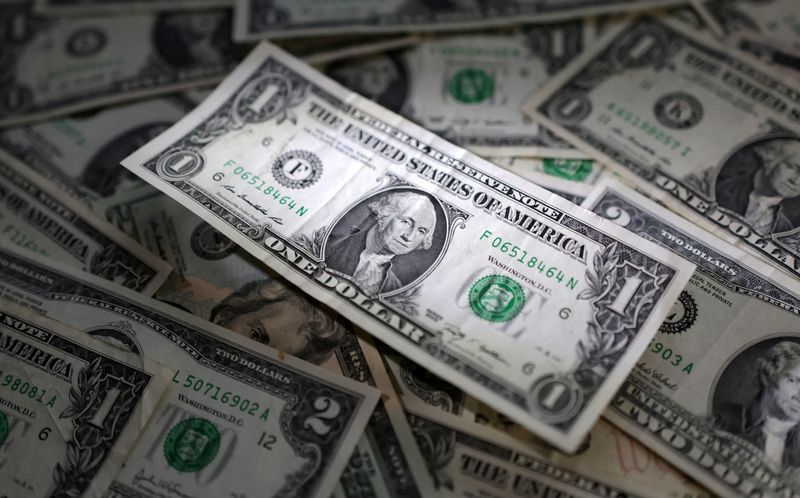By Karen Brettell
(Reuters) -The dollar fell to the lowest level in more than a year against the euro and sterling on Wednesday, after data showed employers added 818,000 fewer jobs in the year to March 2024 than previously thought.
The data was released later than the scheduled time of 1000 EDT, leading to market confusion and some choppy trading.
“It suggests that the labor market was not as strong as the Fed believed and communicated at the time. But it is less clear what this means for the outlook for the future,” said Vassili Serebriakov, a currency strategist at UBS in New York.
“This is very consistent with the Fed starting to cut rates. But it’s harder to say what this means for the pace of easing and other details,” he added.
Traders will focus on Fed Chairman Jerome Powell’s comments on Friday at the Kansas City Fed’s Jackson Hole economic symposium for any new clues about his views on the labor market and whether he is referring to Wednesday’s data.
In particular, markets are looking for clarity on the likely size of a rate cut next month, and whether borrowing costs are likely to be cut at each subsequent Fed meeting.
Traders are pricing in a 33% chance of a 50 basis point cut, little changed from before the jobs data, and a 67% chance of a 25 basis point cut, according to CME Group’s (NASDAQ:) FedWatch Tool.
“It became easier for the Fed to cut rates now and through the end of the year, but I don’t think that makes a strong case for 50 basis points,” said Adam Button, chief currency analyst at ForexLive in Toronto.
“We know it was a year of solid economic growth, that corporate profits were fine and that the economy grew well in the year ending in March,” Button said.
Lower-than-expected job growth in July and an unexpected rise in unemployment had traders pricing in bigger interest rate cuts on worries that the United States faces a looming recession.
These concerns were allayed by better data, including a strong retail sales report for July and also higher-than-expected inflation for the month.
But markets remain highly sensitive to job data for new signs that the economy is deteriorating at a faster pace.
On Wednesday, the Fed will release the minutes of its July 30-31 meeting.
August employment and inflation data will be released after Powell’s speech but before the September meeting.
The euro last fell 0.16% to 101.22, the lowest since December 29. The euro rose 0.11% to $1.1142, the highest since July 2023.
The euro’s strength could weaken after the recent rally, UBS’s Serebriakov said.
“You haven’t seen a big move in US yields. I don’t think the European data is particularly positive for the euro. So it still looks like a bit of a technical move in the currency,” he said.
Sterling strengthened 0.36% to $1.3076, also the highest level since July 2023.
The dollar weakened 0.05% to 145.18 Japanese yen, the lowest level since August 7.
Bank of Japan Governor Kazuo Ueda is expected to discuss the central bank’s decision last month to raise interest rates when he appears in parliament on Friday.
The Bank of Japan will raise interest rates again by the end of the year, according to more than half of economists in a Reuters poll published on Wednesday, with those with an idea which month leaning towards a hike in December.

Data next week shows Japan’s consumer inflation is expected to rise for a third straight month in July, according to a Reuters poll of 18 economists.
In cryptocurrencies, bitcoin rose 0.31% to $59,498.


